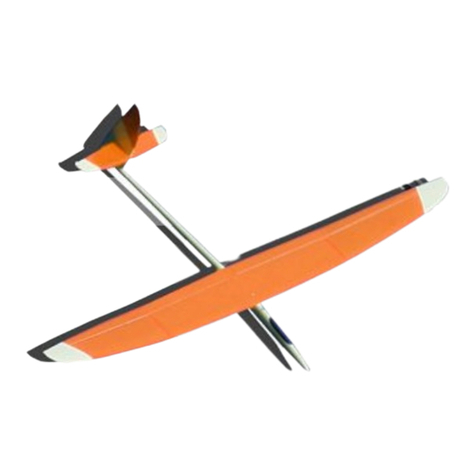
• Gluing of GFK 2mm horns. Best position – the bottom edge of the horns must be 1 mm
behind hinge line. For stabilization in the right position use a little cyano and for perfect sealing
use epoxy with carbon dust or thixotropy agent.
• Glue the servos in using epoxy. Use a proper amount of epoxy so that some epoxy will be
pressed out on the sides of the servos when you push them in. Use some weight fixing the
servos as long as the epoxy hardens to ensure that the servo fits perfect. If the epoxy is thin it
is possible to add some thixotropy agent.
If using servo frames you can wrap the servo in thin food plastic before securing it in the
frame. This way the frame is glued into the wing but servo can be changed if needed.
• Install the threads and clevises whilst the servo arms are set 90 degrees on the servos and
the ailerons / flaps are set in neutral position. Secure the thread to the clevis with extra thin
CA as this is a place with some slop. Oil the hole in the brass horn with a tiny drop of oil for
years of service. Check also thoroughly the clevis pins going into the brass horns and servo
arms. There are clevises that can be poorly made in this special detail. Use the inner most hole
on the servo arms possible to ensure full power of the servo yet providing full throw.
• It is recommended to install clear tape on the ends of the wings. This will prevent the paint
being ripped off when the tape is applied / removed every time you go flying.
• Adjust the aileron throw to: - Speed, thermal and neutral to 28/18mm (27/17 degrees). -
Launch 28/0mm (100% differential) - 20% expo
• Adjust the aileron throw on flaps to - Speed and neutral 6/5mm - Thermal and launch
0/0mm
• Adjust the crow brake flaps to as much as possible (84mm / 75 degrees is good)
• Adjust the crowbrake on ailerons to 5mm up (4 degrees)
• Adjust the camber for launch to 6-10mm flap and aileron equal. Start with 6mm. Camber for
thermal/speed is 2-4mm down / 1-2mm up measured on flaps and equal along the whole
trailing edge. More thermal camber might be used in special weather conditions. Camber for
distance is 1mm up and for speed/zoom 2mm up.
• Cut the servo covers carefully so that the servo horns fit underneath the bumps if needed.
Assembling the fuselage:
• Install the “fuse to wing”-harness in the fuselage. Roughen the
green connector and fuselage fitting before you glue it with
melting glue or cyano. Be careful not to get cyano on contacts as
it can damage contact and current can creep to the sig al wire.
• Install the receiver battery and receiver before servos. 2+2 AA
batteries are recommended though 2+3 and 2x 18650 liion can
also be fitted. It is recommended to pack the receiver in bubble
plastic or equal to absorb shocks. Ensure servos can use the
voltage and secure the front end of the battery to absorb shocks.
Use a voltage regulator if needed.
• Install the fuselage servos (after receiver battery)
• Glue the 2mm clevis couplers to the pushrods roughening the
fiber surface. Pinch the coupler (carefully) with a plier to ensure
tight fit. Check the connection thoroughly. Glue the pushrod tube
to the fuselage between canopy and the leading edge. This point
is very important and is not done from factory because of
different servos used (height)
• If the elevator pin does not go freely in the fuselage opening it
is necessary to turn the pushrod slightly.
• The pin must be fully inserted into the elevator tube to assure
correct throw.
• Screw the elevator to the fuse with adequate force not over
tightening as it will result in damage inside the elevator.
• Adjust the elevator (X-tail) so that it is in neutral checking top
and bottom airfoil (18,5mm measured to fuse). Full throw is 8mm
up and 12mm down (possible 10/17 in thermal/land mode). 40%
expo might be needed for some. At full crow the elevator goes down approximately 4-7mm
One way of installing ballast for
the lightest wings without
ballast tube






















